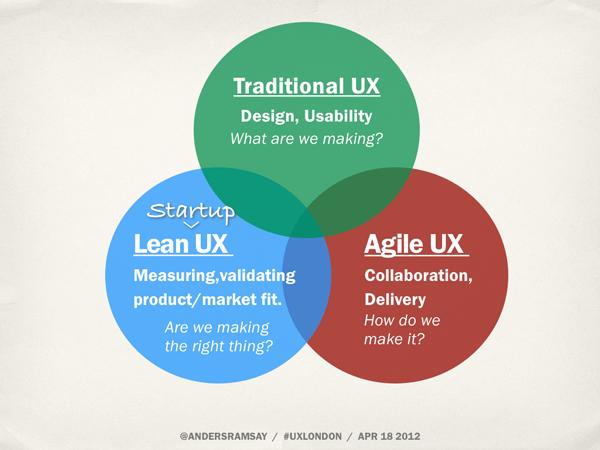Agile and Lean in User Experience

Source: UX
I’ve seen a lot of discussions lately about the difference between Agile UX (User Experience) and Lean UX (User Experience). I’m happy and guilty to admit that I’ve used these terms interchangeably as well, and it seems like they’re all about a more lightweight, iterative approach to UX. However, when I was recently invited to participate in a Lean UX roundtable, I thought it would be a good opportunity to show how different they really are.
Here is the slideshow I made:

Source:UX
This diagram explains the correlation and differences between Traditional UX, Agile UX, and Lean UX.
The Traditional UX
- It Didn't Suddenly Disappear for no Reason
I think it’s easy to think that because you take an agile and/or lean approach to implement user experience practices, all the traditional user experience principles suddenly disappear for no reason. No further conclusions can be drawn beyond this. (in other words, if you have 10 apps to choose from that all have the same basic features, which one do you think people would choose?) The principles of usability and easy design still hold a pivotal position, but all this has made user experience designers hesitate for centuries. Whether we live in an area of agility or lean or insert new terms, good design is good design. The only real difference is how to use these methods when we adopt them. This is the whole essence of agile and lean user experience.
Agile User Experience
- Collaboration and Delivery
The word “agile development” was created by enterprise developers. It looks at software products from the perspective of a developer, similar to the feeling of a kitchen worker looking at a restaurant in this restaurant. This does not mean that everything is placed in front of the house, and the experience part of the restaurant is not as important as it looks, because it is not the main focus. In addition, in established enterprises that regard agile development as the main focus, software products are more similar to restaurants that follow a system. In other words, it is a highly utilitarian system. The focus is to provide the required functions rather than a good user experience. Ward Cunningham, an original signer of the Agile Manifesto, once said in Cooper’s revisit of the Agile user experience, “Agile is fast serving hot food.”
Basically, agile development refers to the high-quality and high-speed delivery of working software. In the world of agile development, this is the fundamental measure of progress. However, an interesting thing happened during the implementation of the Agile Manifesto. It turns out that we need to work efficiently with cumbersome, non-binary objects called “people” if we're going to roll out a good piece of software quickly. Although UX design has been largely unknown up to this point, agile development thinking provides a fundamental paradigm that can make a difference, that is, how to communicate with your team members at a basic and deep level.
Therefore, although the agile development thinking in software delivery (such as automating everything that can be automated) is worth learning from user experience designers, the result that is really worth learning from user experience practitioners is the part about cooperation. Agile UX methods, such as organized design studios and cross-functional pairings, allow UX practitioners to replace once-slow paper document reading with fast and effective direct interactive communication. In other words, an Agile UX practice is one that replaces document-centricity with a collaboration-centric one. This is one of the big things a UX designer in an agile development team needs to do. This shift is key to enabling designers to integrate their own practices with those of agile developers.
Lean (Start-up) User
Experience - Measuring and Verifying the Fitness of Products and Markets
Now we have this great agile development mechanism, which allows us to bring software to market with high efficiency, which is cool. However, does anyone go to see if the software we launch is suitable? The lean user experience method shows us that the launch of software is basically a success in the agile development field, but the real situation is that this is just the beginning. Agile development methods help user experience designers change the old design methods and make communication their first task, while lean user experience subverts our old methods of investigating research and testing quality.
In the traditional model, we investigate what you do before you start building a product, in order to understand what kind of product you want to build. In a Lean approach, we need to continuously build and collect metrics related to the products we create. The most typical example of this is the collection of metrics for landing pages, which is created and implemented at the beginning of the project, rather than when the product is almost “done.” We turned what was once seen as just a marketing blunder into an actual hypothesis experiment so that others would think that our idea was the same as we had imagined before. Then, the data content gleaned from the landing page (or it could evolve into a full metrics collection site) is fed back into the product design.
But a landing page is just one of the lean user experience design methods that many designers can use. Another common pattern is to create a simple prototype and prototype product or “get out of your building!” Many user experience designers verbally say that the plan is designed with a user-centered concept, but in fact they do not really spend a lot of time understanding their users. No matter what they do, the prototype product can reshape the concept of user-centered design, which is a good stimulus for user experience designers to walk out of comfortable rooms and offices and bring their ideas to users to communicate with them.
We implement this model for research during the product design and delivery process, rather than the pre- and post-production stages. In an Agile UX model, architectural design is designing buildings, but in a Lean UX model, architectural design is researching architecture. Clearly, the two concepts are very intersecting. Agile UX, for example, can be more easily integrated into the work of an agile development team for research because it is continuous and not just an upfront investment.
One more thing I have to say about Lean UX: I think it's a bit confusing. The term "lean" originates from lean manufacturing and refers to the practice of minimizing waste and maximizing flow, which in turn is the cornerstone of agile development methodologies. Lean UX, on the other hand, is in fact a reference to The Lean Startup, by Eric Ries (and Steve Bronke, who is the godfather of the Lean Startup and the creator of Customer Development and Getting Out of the Building Creator of these concepts), it extends the idea of agile development, which includes the early and continuous design and delivery work that you are actually doing, which is conducive to expanding the product market.
 philip
philip 2023-03-16 17:58:00
2023-03-16 17:58:00 992
992







